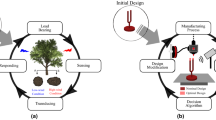Abstract
Mass customization of products that interface with the human body poses unique problems due to the complexities of bio-interface design, the lack of biomechanical techniques in traditional mechanical design, and the absence of specific parametric strategies. Current biomechanical design often follows craftsman-like design processes using less than state-of-the-art tools and techniques. Thus, products that interface with the human body are not readily parameterized or automated. This paper presents a strategy for implementing mass customization in the design of mechanical devices that interface with the human body. This strategy is based on three methods that include: a method for capturing and representing the human body so that the model can be used with state-of-the-art tools and solid modeling techniques, a design methodology based on feature structure planning allowing the design process to be reused and automated, and a strategy for identifying parametric variables tied to the human body. A case study is presented to illustrate the proposed process.
Similar content being viewed by others
Explore related subjects
Discover the latest articles and news from researchers in related subjects, suggested using machine learning.References
Anatomical Positions, Directions, and Planes, UCLA Online Manual, http://www.oandp.com/news/jmcorner/library/uclamanual/UCLA-01.pdf (Accessed March, 2006).
Anthropology CSU Sacramento: skeleton-anatomical plane website, http://www.csus.edu/anth/physanth/BONES%20HTM/18_anatomical%20plane.htm (Accessed March, 2006).
Bronsvoort S.L., Jensen F.W. (1993) Feature modeling and conversion—key concepts to concurrent engineering. Computers in Industry 21(1): 61–86
Davis S. (1987) Future perfect. Addison-Wesley Publishing Company Inc, Reading, MA
Floyd W.F., Roberts D.F. (1958) Anatomical and physiological principles in chair and table design. Ergonomics 2: 1–16
Gilmore J., Pine J.B. (1997) The four faces of mass customization. Harvard Business Review 75(1): 91–101
Goonetilleke R.S. (1988) Designing to minimize discomfort. Ergonomics in Design 6(3): 12–19
Goonetilleke, R. S. (2002). Do we know enough to design comfortable products? In Proceedings of 2002 International CIRP Design Seminar, Hong Kong, pp. 1–4.
Goonetilleke, R. S., & Eng, T. J. (1994). Contact area effects on discomfort. In Proceedings of the Human Factors and Ergonomics Society 38th Annual Meeting, pp. 688–680.
Hertzberg H.T.E. (1972) The human buttock in sitting: Pressures, patterns, and plliatives. American Automobile Transactions 72: 39–47
Hoffmann C.M., Kim K.J. (2001) Towards valid parametric CAD models. Computer-Aided Design 33: 81–90
Introduction to the Human Body/Anatomical Terminology/Planes of the Body, http://training.seer.cancer.gov/module_anatomy/unit1_3_terminology2_planes.html (Accessed March, 2006).
Jensen, C. G., Tucker, S. S., Jones, C. J., & Rohm, T. (2000a). Concurrent engineering with parametric design. In Proceedings of the Third World Congress on Intelligent Manufacturing Process & Systems. Cambridge, MA.
Jensen, C. G., Tucker, S. S., Jones, C. L., & Tomikashi, M. (2000b). Parametric engineering design tools and applications. In Proceedings of the 2000 Design Engineering and Technical Conferences, Baltimore, MD, DETC 2000/DAC-14275.
Jones, C. L. (2001). Parametric model behavior across multiple CAD systems. Masters Thesis, Brigham Young Universtiy, Provo, UT.
Lampel J., Mintzberg H. (1996) Customizing customization. Sloan Management Review 38: 21–30
Lewark E.A., Nurre J.H. (1998) Automated fudicial labeling on human body data. In Proceedings of SPIE, The International Society for Optical Engineering 3313: 82–89
Ma W., He P. (1998) B-spline surface local updating with unorganised points. Computer Aided Design 30(11): 165–172
Ma Y.Y., Zhang H., Jiang S.W. (2004) Realistic modeling and animation of human body based on scanned data. Journal of Computer Science and Technology 19(4): 529–537
Pine J.B. (1993) Mass customizing products and services. Planning Review 21(4): 6–13
Pool, T. C. (1998). Product templates: A parametric based approach to product development. Masters Thesis, Brigham Young University, Provo, UT.
Ramaswamy R., Ulrich K., Kishi N., Tomikashi M. (1993) Solving parametric design problems requiring configuration choices. Journal of Mechanical Design 115: 20–28
Roach, G. (2003). The Product design generator—a next generation approach to detailed design. Ph.D. Dissertation, Brigham Young University, Provo, UT.
Rohm, T. (2001). Graphical creation of CAD parametric application programs. Masters Thesis, Brigham Young Universtiy, Provo, UT.
Roller, D. (1998). Foundation of parametric modeling. Parametric and variational design. Germany: B.G. Teubner Stuttgart.
Scheepers, F., Parent, R. E., Carlson, W. E., & May, S. F. (1997). Anatomy-based modeling of the human musculature. In Computer Graphics Proceedings, SIGGRAPH 97 (pp. 163–172). New York, NY: ACM.
Seo, H., & Magnenat-Thalmann, N. (2003). An automatic modeling of human bodies from sizing parameters. In Proceedings of the 2003 Symposium on Interactive 3D Graphics, Monterey, CA, pp. 19–26.
Shah J.J., Sen S., Ghosh S. (1991) An intelligent CAD environment for routine mechanical design. Computers in Engineering 1: 111–117
Spingle S., Chung K.C., Brubaker C.E. (1990) Reduction of sitting pressures with custom contoured cushions. Journal of Rehabilitation Research Development 27: 135–140
Tucker, S. S. (2000). Parametric application program interface function mapping of computer-aided design systems. Masters Thesis, Brigham Young University, Provo, UT.
Ulrich K.T., Eppinger S.D. (1995) Product design and development (3rd ed). McGraw-Hill, Inc, New York
Wang C.C.L. (2003) Parameterization and parametric design of mannequins. Computer Aided Design 37: 83–98
Wilhalms J., & Van Gelder, A. (1997). Anatomically based modeling. In Computer Graphics Proceedings, SIGGRAPH 97 (pp. 173–180) New York, NY: ACM.
Zhang L., Helander M.G., Drury C.G. (1996) Identifying factors of comfort and discomfort in sitting. Human Factors 38(3): 377–389
Ziolek, S. A., & Kruithof P. C. (2000). Human modeling and simulation: A primer for practitioners. In Proceedings of the International Ergonomics Association and the 44th Annual Meeting of the Human Factors and Ergonomics Association, pp. 825–827.
Author information
Authors and Affiliations
Corresponding author
Rights and permissions
About this article
Cite this article
Jensen, K.A., Cox, J.J. Bio-surfaces and geometric references for mass customization in bio-interface design. J Intell Manuf 19, 553–564 (2008). https://doi.org/10.1007/s10845-008-0133-1
Accepted:
Published:
Issue Date:
DOI: https://doi.org/10.1007/s10845-008-0133-1




